Unveiling the Fiery Beauty: Exploring Volcano Tourist Attractions in Hawaii

Exploring the Fiery Majesty: Volcano Tourist Attractions in Hawaii
Hawaii, a tropical paradise known for its stunning beaches and lush landscapes, is also home to one of nature’s most awe-inspiring spectacles – volcanoes. These majestic volcanic formations have not only shaped the islands’ geography but have also become popular tourist attractions for visitors from around the world. Join us as we delve into the captivating world of volcano tourism in Hawaii.
The Big Island of Hawaii is home to two prominent active volcanoes: Kilauea and Mauna Loa. Kilauea, often called the “world’s most active volcano,” has been continuously erupting since 1983, making it an ever-changing landscape that captivates all who witness its power. The Hawaii Volcanoes National Park offers visitors a chance to experience this raw force of nature up close. Guided hikes and scenic drives allow you to explore lava fields, steaming vents, and even witness lava flowing into the ocean.
For those seeking an adrenaline rush, helicopter tours offer a breathtaking aerial view of these volcanic wonders. As you soar above the craters and lava flows, you’ll gain a unique perspective on the magnitude and beauty of these geological marvels.
Not far from Kilauea lies Mauna Loa, one of Earth’s largest shield volcanoes. Although it hasn’t erupted since 1984, its presence looms large over the island. Hiking enthusiasts can embark on an unforgettable journey along Mauna Loa’s trails, traversing otherworldly landscapes dotted with cinder cones and ancient lava flows. As you ascend to higher elevations, you’ll be rewarded with panoramic views that stretch as far as the eye can see.
If you’re looking for a more immersive experience, consider exploring lava tubes – natural tunnels formed by flowing lava. These underground passages provide a glimpse into Hawaii’s volcanic past while showcasing unique geological formations. Thurston Lava Tube, located within the Hawaii Volcanoes National Park, is a popular destination for visitors to explore these captivating subterranean wonders.
Beyond the Big Island, other islands in the Hawaiian archipelago offer volcanic attractions as well. On Maui, the Haleakala National Park boasts a dormant volcano that last erupted over 500 years ago. Witnessing the sunrise from the summit of Haleakala is a bucket-list experience that offers breathtaking views and a sense of tranquility.
While visiting these volcanic attractions, it’s important to remember that volcanoes are powerful and unpredictable forces of nature. Always follow safety guidelines provided by park rangers and local authorities to ensure your visit is both enjoyable and secure.
Volcano tourism in Hawaii offers an unparalleled opportunity to witness the dynamic forces that have shaped these beautiful islands. Whether you choose to hike through lava fields, take a helicopter tour, or explore underground lava tubes, you’ll be left with memories that will last a lifetime. So come and immerse yourself in the fiery majesty of Hawaii’s volcanoes – an experience like no other awaits you!
Exploring Volcano Tourist Attractions in Hawaii: Answers to Your Top 4 FAQs
- What can tourists do in Hawaii Volcanoes National Park?
- Which volcano should I visit in Hawaii?
- What is the best active volcano to visit in Hawaii?
- Where is the best place to see a volcano in Hawaii?
What can tourists do in Hawaii Volcanoes National Park?
Hawaii Volcanoes National Park offers a wide range of activities and attractions for tourists to enjoy. Here are some of the top things to do in the park:
- Crater Rim Drive: Take a scenic drive along Crater Rim Drive, a 10.6-mile loop that offers stunning views of the park’s volcanic landscapes. Stop at various overlooks and viewpoints to admire the Kilauea Caldera, steam vents, and other volcanic features.
- Kilauea Visitor Center: Start your visit at the Kilauea Visitor Center, where you can gather information about the park’s geology, history, and safety guidelines. Rangers are available to answer questions and provide guidance on hiking trails and current volcanic activity.
- Thurston Lava Tube: Explore the unique Thurston Lava Tube, a naturally formed tunnel created by flowing lava. Walk through this underground passage and marvel at its impressive rock formations.
- Chain of Craters Road: Drive along Chain of Craters Road, a 19-mile scenic route that descends from the summit area to the coast. Along the way, you’ll encounter various volcanic features such as lava fields, craters, and petroglyphs.
- Halema’uma’u Crater Overlook: Visit the Halema’uma’u Crater Overlook to witness the mesmerizing glow of Kilauea’s active volcano crater at nightfall. The sight of molten lava illuminating the night sky is truly awe-inspiring.
- Hiking Trails: Lace up your hiking boots and explore one of the many hiking trails in the park. Options range from easy walks like Devastation Trail to more challenging treks like Kīlauea Iki Trail or Mauna Ulu Trail. Each trail offers unique views of volcanic landscapes and opportunities to witness ongoing geological processes.
- Jaggar Museum: Pay a visit to the Jaggar Museum, which provides exhibits on volcanology and showcases geological artifacts. Here, you can learn about the history of volcanic eruptions in Hawaii and observe seismographs tracking current volcanic activity.
- Volcano House: Enjoy a meal or stay overnight at the historic Volcano House, located within the park. This iconic hotel offers breathtaking views of Kilauea Caldera and provides a comfortable base for exploring the park’s attractions.
- Ranger Programs: Participate in ranger-led programs and guided walks to gain deeper insights into the park’s natural wonders. These educational programs cover topics such as geology, native flora and fauna, and Hawaiian culture.
- Backcountry Camping: For those seeking a more immersive experience, backcountry camping is available within designated areas of the park. Permits are required, but it allows you to spend more time exploring remote corners of the park.
Remember to check with park rangers for any closures or safety alerts before embarking on your adventure in Hawaii Volcanoes National Park. Respect the natural environment and follow all guidelines to ensure a safe and enjoyable visit while preserving this remarkable volcanic landscape for future generations to appreciate.
Which volcano should I visit in Hawaii?
When it comes to choosing which volcano to visit in Hawaii, it ultimately depends on your preferences and the current volcanic activity. Here are two prominent options to consider:
1. Kilauea: Located on the Big Island of Hawaii, Kilauea is known as one of the world’s most active volcanoes. It offers a dynamic and ever-changing landscape due to its ongoing eruptions since 1983. Visiting Kilauea provides an opportunity to witness lava flows, steaming vents, and explore the captivating Hawaii Volcanoes National Park. Keep in mind that volcanic activity can vary, so it’s essential to check with local authorities or park rangers for updates before planning your visit.
2. Haleakala: Situated on Maui, Haleakala is a dormant volcano that last erupted over 500 years ago. While it may not offer the same active lava flows as Kilauea, Haleakala provides a unique experience. Visitors can witness breathtaking sunrises from its summit at Haleakala National Park, which offers panoramic views of the island and its surrounding beauty.
Both options have their own distinct charms and attractions. If you’re interested in witnessing active volcanic activity and exploring lava fields, Kilauea on the Big Island is a great choice. On the other hand, if you prefer a dormant volcano with stunning sunrise views and a sense of tranquility, then Haleakala on Maui might be more suitable.
Remember to stay informed about volcanic activity by checking with local authorities or park officials before planning your visit. They will provide up-to-date information regarding safety guidelines and any restrictions that may be in place during your trip.
What is the best active volcano to visit in Hawaii?
When it comes to visiting active volcanoes in Hawaii, one of the most popular and accessible choices is Kilauea on the Big Island. Kilauea has been continuously erupting since 1983, making it one of the world’s most active volcanoes. Located within the Hawaii Volcanoes National Park, it offers a range of opportunities for visitors to witness its awe-inspiring power.
The park provides various ways to explore Kilauea, including guided hikes, scenic drives, and overlooks that allow you to observe lava flows and steaming vents. The ever-changing landscape of Kilauea offers a unique experience each time you visit. You may witness lava cascading into the ocean, glowing rivers of molten rock, or even new land formations being created right before your eyes.
Additionally, the Hawaii Volcanoes National Park offers educational exhibits and ranger-led programs that provide valuable insights into the geological significance and cultural history of Kilauea. From exploring lava tubes to hiking across vast lava fields, there are plenty of opportunities for adventure and discovery within this remarkable volcanic landscape.
It’s important to note that volcanic activity can vary over time, so it’s advisable to check with park authorities or visitor centers for updates on current conditions before planning your visit. Safety is always a top priority when visiting an active volcano, so be sure to follow any guidelines provided by park officials.
While Kilauea is often considered the best active volcano to visit in Hawaii due to its ongoing eruption and accessibility, other islands in the Hawaiian archipelago also offer volcanic attractions worth exploring. For example, Haleakala on Maui is a dormant volcano that provides stunning views and unique experiences like watching sunrise from its summit.
Ultimately, choosing the “best” volcano depends on personal preferences and interests. Each volcano in Hawaii offers its own distinct features and allure. Whether you choose Kilauea or another volcanic destination in Hawaii, you’re in for an unforgettable experience that showcases the raw power and beauty of nature.
Where is the best place to see a volcano in Hawaii?
When it comes to witnessing volcanoes in Hawaii, the best place to see one largely depends on your preferences and the current volcanic activity. However, there are a few notable locations that offer remarkable volcano viewing experiences:
- Hawaii Volcanoes National Park (Big Island): This park is home to the Kilauea volcano, one of the most active volcanoes on Earth. It offers a range of opportunities to witness volcanic activity, including guided hikes, scenic drives along Crater Rim Drive, and overlooks such as Jaggar Museum and Halema’uma’u Crater.
- Haleakala National Park (Maui): While Haleakala is a dormant volcano, its summit area provides breathtaking views of its massive crater. Watching the sunrise from Haleakala’s summit is an unforgettable experience that offers panoramic vistas and an otherworldly atmosphere.
- Pu’u ‘O’o Vent (Big Island): Located within the Hawaii Volcanoes National Park, Pu’u ‘O’o Vent was once a prominent active vent of Kilauea volcano. While it has been inactive since 2018, it played a significant role in shaping the landscape and witnessing its remnants can be fascinating.
- Chain of Craters Road (Big Island): This scenic road within the Hawaii Volcanoes National Park takes you through a diverse range of volcanic landscapes. Along the way, you can witness ancient lava flows, sea cliffs formed by lava entering the ocean, and various volcanic features.
- Mauna Loa Lookout (Big Island): For panoramic views of Mauna Loa – one of Earth’s largest shield volcanoes – head to Mauna Loa Lookout in Hawaii Volcanoes National Park. From here, you can admire the vastness and grandeur of this dormant volcano.
Remember that volcanic activity can change over time, so it’s essential to check with local authorities or park rangers for up-to-date information and safety guidelines before planning your visit.
